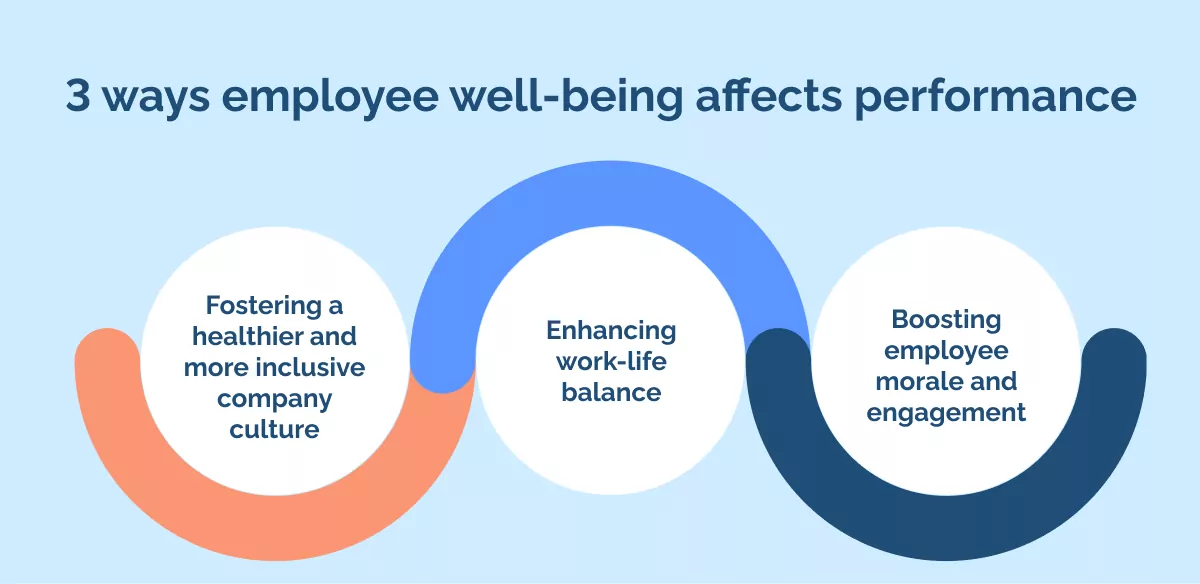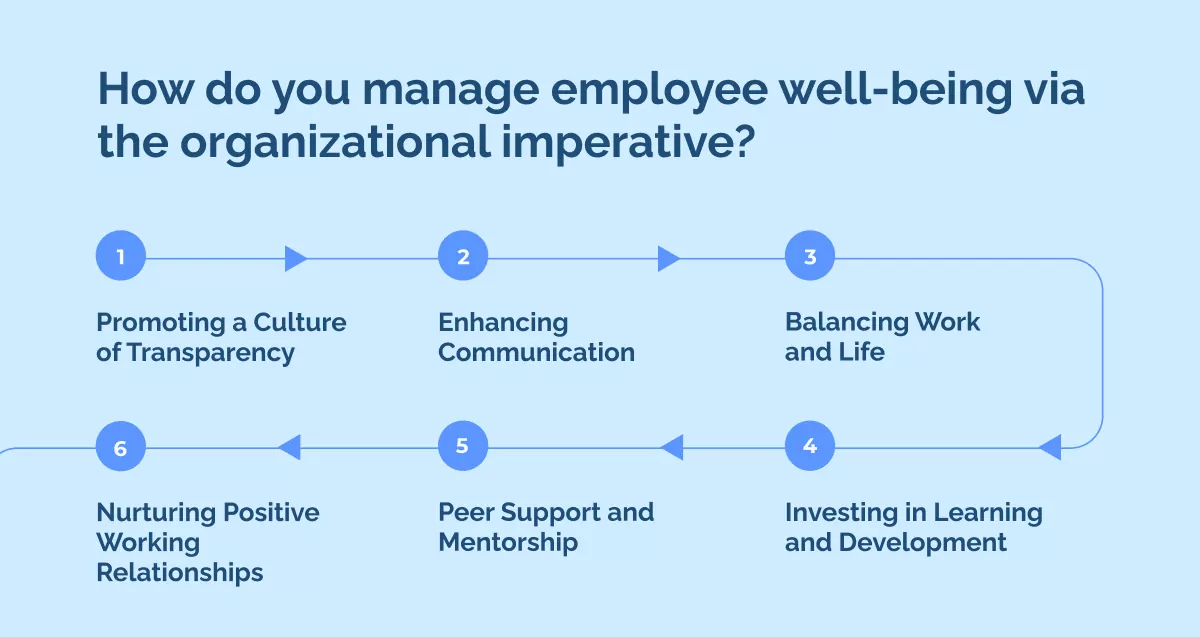
Many terms in business sound overly complicated but are simple when you break them down and apply them in the business environment.
Organizational imperative is one of the best examples, as it sounds unfamiliar, but the concept is something we practice every day in the office or remote workplaces.
Everything that the change leadership and team members do as a company working toward organizational change is part of the organizational imperative successful companies use to solve market complexity in a constantly changing business environment.
In a 2023 survey on the state of organizations, only 25% of staff felt that their leaders were passionate and engaged enough to inspire them to excel in their roles.
To help you understand what the organizational imperative is and how you can use it to inspire and improve well-being, we will explore the following topics:
- What is the organizational imperative?
- How does the employee well-being scale impact the organizational imperative?
- 3 ways employee well-being affects performance
- How can well-being support organizational imperative goals?
- How do you manage employee well-being via the organizational imperative?
What is the organizational imperative?
The organizational imperative is the shared directive of a group of people, all working to accomplish a singular task or tasks that share the same goals and parts of the exact base requirements to unlock untapped market potential.
By doing so, such teams form a structured, symbiotic organization intended to achieve a goal more effectively and reliably.
How does the employee well-being scale impact the organizational imperative?
The employee well-being scale relates closely to the success of any organizational imperative, as you must maintain the health of your staff for them to effectively and successfully work toward shared goals.
Employee well-being is a critical factor in achieving organizational imperatives. Recent statistics from 2022 onwards highlight this connection.
A 2022 survey found that organizations actively investing in employee well-being initiatives experienced a 27% increase in employee engagement compared to those that did not prioritize well-being.
This statistic underscores the direct impact of well-being on organizational imperatives such as improved productivity and employee satisfaction.
When employees receive support for their well-being, they are more engaged, productive, and committed, all essential for working toward the organizational imperative.
Investing in employee well-being is not just a matter of altruism but a strategic imperative for organizations aiming to thrive in today’s competitive landscape.
3 ways employee well-being affects performance
Employee well-being affects performance in three main ways.
On one end of the scale, the latest official data shows that 32.5 million working days went to work-related ill health, with stress, anxiety, and depression accounting for almost 18 million.
On the more optimistic end of the scale, a 2023 survey (cited above) shows that the best-performing members of an organization perform 800% higher than the lowest-performing members of the team, underscoring the importance of well-being in increasing employee productivity and performance.
Well-being affects employee performance in many ways, from boosting morale to fostering a healthier culture.
1. Fostering a healthier and more inclusive company culture
Well-being initiatives also play a pivotal role in shaping an organization’s culture. A workplace that values well-being sends a clear message to its employees about its commitment to their welfare.
When middle management receives support to promote these company values, they can foster a positive and inclusive culture where employees are more likely to collaborate, support one another, and stay committed to organizational objectives.
A strong well-being culture aligns with and reinforces the pursuit of imperative goals, creating a harmonious and thriving organizational ecosystem.
2. Enhancing work-life balance
Employee well-being has a profound impact on work-life balance and performance. When employees experience good physical and mental health, they gain the skills to harmonize their work and personal lives.
This equilibrium reduces stress and burnout, enhancing overall job satisfaction.
Employees who feel supported in their well-being are more likely to be committed to their tasks and contribute positively to their organizations.
In essence, prioritizing employee well-being creates a virtuous cycle of maintaining work-life balance, leading to heightened job performance and greater overall satisfaction.
3. Boosting employee morale and engagement
Employee well-being has a powerful influence on employee morale and engagement. When organizations prioritize their workforce’s physical, mental, and emotional health, it conveys that employees are valued.
This action fosters a positive and supportive work environment, boosting morale.
Employees who feel well-cared for are more likely to be engaged in their work, as they experience lower stress levels and higher job satisfaction.
They become motivated to contribute their best efforts, collaborate with colleagues, and align with the organization’s goals.
Ultimately, employee well-being catalyzes increased morale and engagement, creating a more vibrant and productive workplace.
How can well-being support organizational imperative goals?
There are five steps to business leaders using well-being to support the organizational imperative, beginning with enhanced employee engagement.
1. Enhanced Employee Engagement
Prioritizing employee well-being can increase engagement and success in achieving business objectives.
Employees who feel valued and supported in their physical and mental health are more likely to be emotionally committed to their work and the organization’s goals across business units.
2. Improved Productivity
Well-being initiatives can contribute to higher productivity levels within a robust performance culture.
Healthy employees have more energy and focus, enabling them to accomplish tasks more efficiently and effectively, which aligns with achieving imperative goals.
3. Reduced Absenteeism
Addressing well-being concerns can lead to a decrease in absenteeism. Employees who are physically and mentally well are less likely to take sick leave, ensuring a consistent workforce to pursue organizational objectives.
4. Enhanced Team Collaboration
A focus on well-being can promote better teamwork. Employees who feel supported and healthy are more likely to collaborate effectively, which can be instrumental in achieving complex organizational goals.
5. Greater Innovation and Problem-Solving
Employee well-being can foster a conducive environment for innovation and creative problem-solving.
When employees are mentally and emotionally well, they are more likely to contribute innovative ideas and strategies, supporting imperative goals related to growth and adaptation.
How do you manage employee well-being via the organizational imperative?
There are many strategies to manage employee well-being via the organizational imperative, starting with promoting a culture of transparency.
Promoting a Culture of Transparency
Foster a culture of openness within the organization by regularly engaging with team members to assess their well-being and identify potential stressors.
Incorporate discussions on well-being and stress into team meetings to encourage open dialogue, cultivate positive attitudes, and normalize conversations about mental health.
This approach encourages employees and staff to consider their mental health and the factors that influence it.
Enhancing Communication
Effective communication is crucial to prevent stress. Insufficient or unclear communication negatively impacts employee well-being and engagement.
Staff can feel overwhelmed by excessive, unmanageable information or excluded from critical discussions.
Encourage transparent, open, and responsive communication, enabling employees to access necessary information without feeling overwhelmed.
Balancing Work and Life
Sustained pressure and an unhealthy work-life balance can lead to stress and burnout, harming productivity, creativity, and morale.
Encourage employees to maintain sensible working hours, take regular lunch breaks, rest after busy periods, avoid weekend work, and use their annual leave.
Implement flexible working arrangements, such as adjusted schedules, to support healthier and more productive work habits.
Investing in Learning and Development
Valuing employees and investing in their skills and development creates a positive culture that fosters trust and commitment.
Provide cost-effective development opportunities through internal coaching, learning, training, and job-shadowing initiatives alongside the in-app guidance provided by a digital adoption platform to allow staff to develop their skills as they complete tasks continuously.
Managers should engage in regular work-related conversations with employees, reinforcing their value.
Peer Support and Mentorship
Implement peer support systems, buddy programs, and mentoring schemes to provide alternative avenues for employees to seek guidance and support outside their direct managers.
These programs maximize the diverse skills and experiences within the organization and help employees gain confidence and develop new skills.
Nurturing Positive Working Relationships
Promote a supportive workplace environment by encouraging teamwork, collaboration, and information-sharing.
Emphasize positive behaviors and help employees identify them quickly to prevent conflicts and ensure fairness.
Maintain clear anti-bullying and harassment policies and actively promote social activities and exercise to boost staff health, teamwork, and mental well-being.
Use a DAP to support organizational imperative goals
Utilizing a DAP (digital adoption platform) bolsters organizational imperative goals for future-ready organizations. With data-driven insights at the forefront, a DAP empowers informed decision-making, enhances operational efficiency, and fosters strategic alignment.
A DAP bridges the gap between raw data and actionable intelligence, facilitating agility and adaptability for future-ready companies.
In an increasingly competitive landscape, harnessing the potential of a DAP becomes synonymous with driving success, innovation, and achieving the core objectives that drive an organization forward as strategic priorities change.
FAQs
What is the employee wellbeing scale?
The Employee Well-Being Scale helps organizations assess the level of well-being of their staff using an 18-point scale comprised of three areas of well-being:
- Life well-being (LWB).
- Work well-being (WWB).
- Psychological well-being (PWB).
The scale contains six items for each domain.
What is an imperative in business?
A business imperative is a crucial goal or task for significant progress toward realizing its strategic vision. Organizations focus on business imperatives to unlock their full business potential.
Tristan Ovington
Tristan Ovington is a professional senior writer and journalist, specializing in providing expert insights on various topics such as digital adoption, digital transformation, change management, and Cloud apps. He delivers his knowledge through accessible online content that is data-driven and presented in a friendly tone, making it easy for readers to understand and implement.







